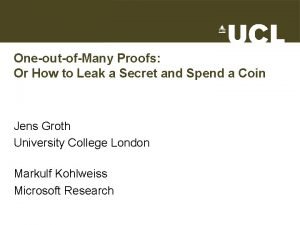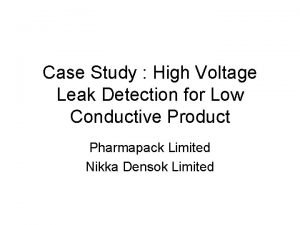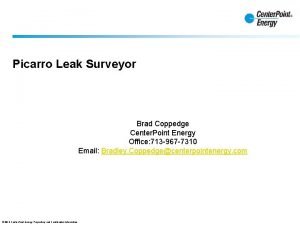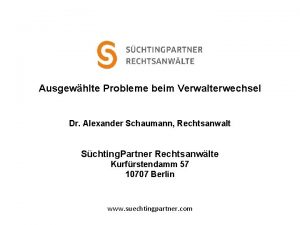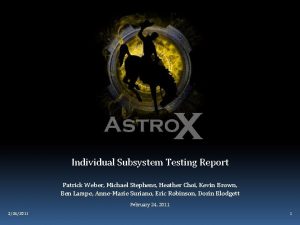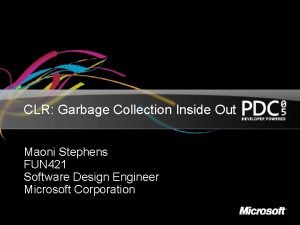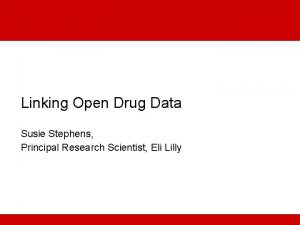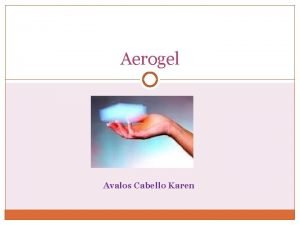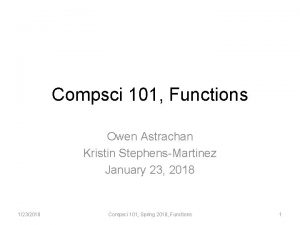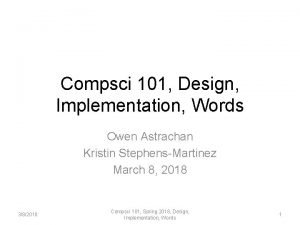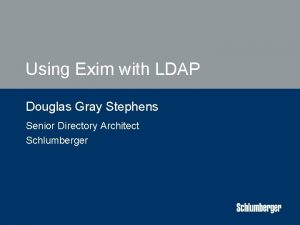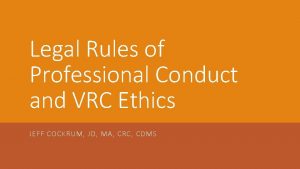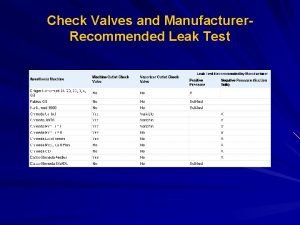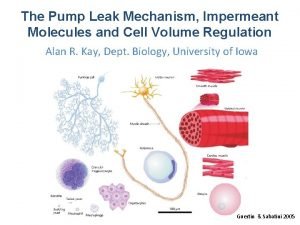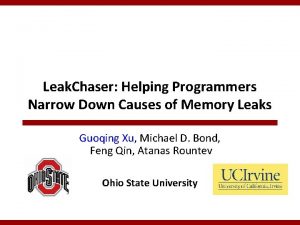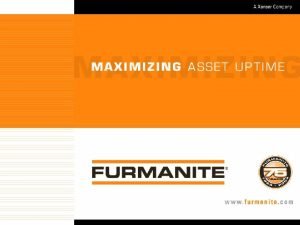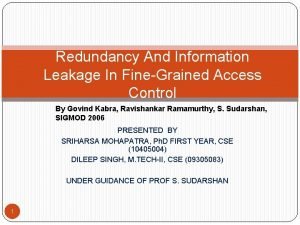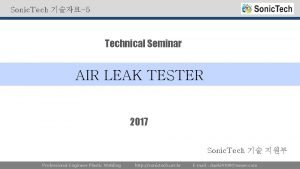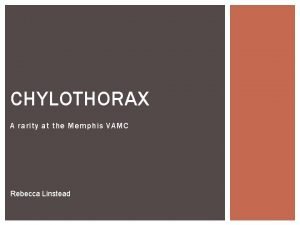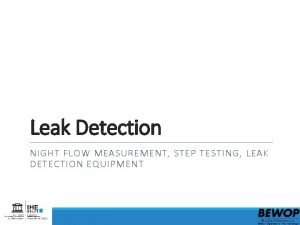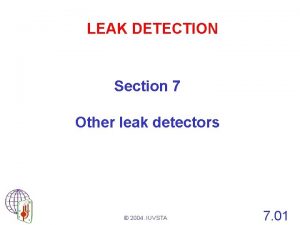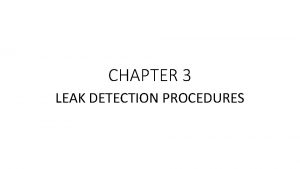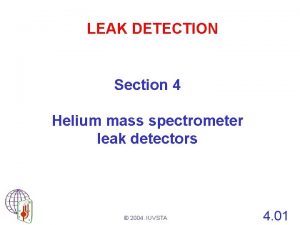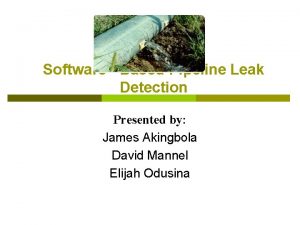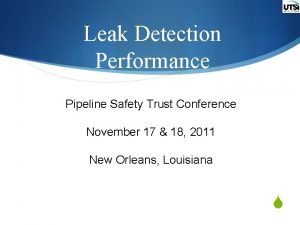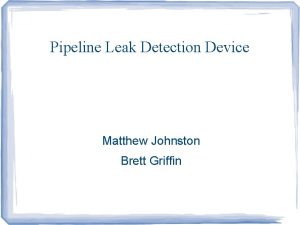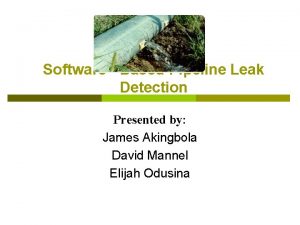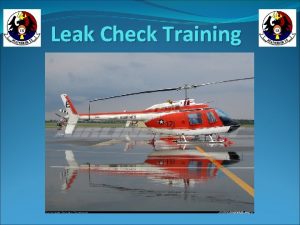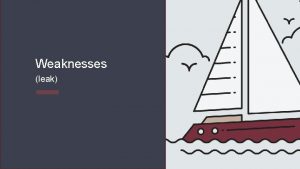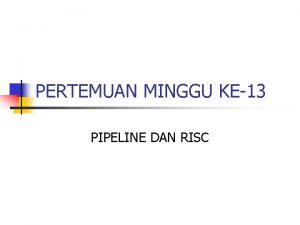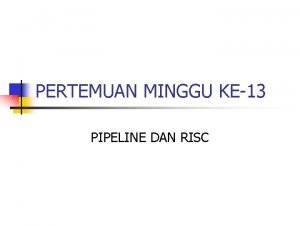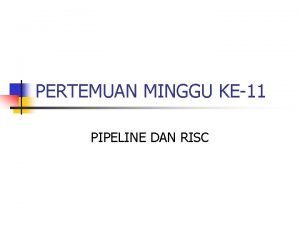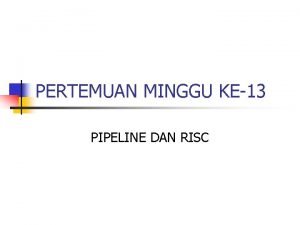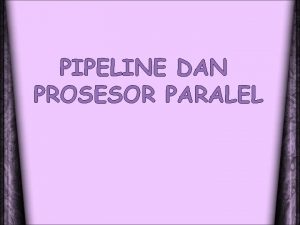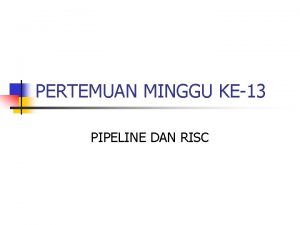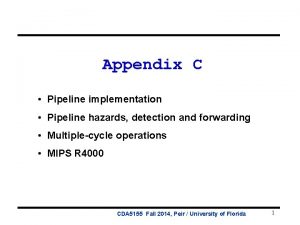PIPELINE LEAK DETECTION Eric Penner Josh Stephens 43009



















































- Slides: 51

PIPELINE LEAK DETECTION Eric Penner Josh Stephens 4/30/09

OVERVIEW Introduction Methods of Leak Detection Cost Comparison

Introduction

WHERE ARE PIPELINES LOCATED? Roughly 500, 000 miles of pipeline in US 300, 000 miles of gas pipeline 200, 000 miles of oil pipeline About 1. 2 million miles of pipeline in the world Russia and Canada are next two on list with ~250, 000 miles and 100, 000 miles of pipeline, respectively

DIFFERENT PIPELINE SYSTEMS

SIGNIFICANT INCIDENTS Significant incidents meet any of the following conditions as defined by the PHMSA Fatality or injury requiring hospitalization $50, 000 or more in total costs, measured in 1984 dollars Highly volatile liquid releases of 5 bbls or more or other liquid releases of 50 bbls or more Any liquid releases resulting in an unintentional fire or explosion

SIGNIFICANT INCIDENTS 1988 -2008

WHAT ARE THE PRIME CAUSES? Excavation damage is the number one cause Most experts regard corrosion as second leading cause, feeling that a strong portion of those under the “All Other Causes” heading are corrosion related as well

Methods of Leak Detection

HARDWARE LEAK DETECTION Pros Generally good sensitivity � Cons Able to detect large and small leaks quickly Leak location can be estimated via instrumentation Previous two points help minimize environmental and economic impact in event of leak High level of instrumentation Installation and maintenance costs can be relatively high Complex installations Considerable amount of below surface activity

IN BRIEF: ACOUSTIC EMISSIONS Method relies on escaping fluid giving off a low frequency acoustic signal Acoustic sensors placed around entire length of pipeline to monitor interior pipeline noise Baseline or “acoustic map” created Deviation from baseline triggers system alarm

IN BRIEF: VAPOR SENSOR METHOD Vapor sensing tube placed along entire length of pipeline Tube is permeable to material being transported If leak occurs, some material diffuses into tube Test gas is pumped through and analyzed for vapors of pipeline fluid

IN BRIEF: ULTRASONIC FLOW METER Generates an axial sonic wave in pipe wall Difference in time for wave to travel upstream and downstream allows for computation of flow rate Relies on mass flow balance

FIBER OPTIC SENSING: BASICS Probes placed along pipeline every 0. 5 meters Escaping hydrocarbons change surrounding temperature Liquid leaks ↑ T Gas leaks ↓ T (Joule Thompson effect) Scattered light analysis Raman (intensity based) Brillouin (frequency based)

PERFORMANCE AND COST Measurement Performance Sensitivity 50 ml/min Leak Size Magnitude estimated Leak Location Within 1 meter Detection Time 30 seconds to 5 minutes Cost 1200 km single pipeline Roughly ~$18 million in equipment costs alone Figure the distance from Houston to El Paso does not include installation Conclusion: fiber optic leak detection requires a sizeable upfront investment

SOFTWARE LEAK DETECTION - Instrumentation is used to measure internal parameters of the pipeline - What methods are available? 1. 2. 3. Balancing Systems Pressure Analysis Generalized Likelihood Ratio

BALANCING SYSTEMS Basic principle is conservation of mass Basic line balance does not compensate for changes in line pack due to pressure, temperature, or product composition Volume balance is an enhanced, automated technique, which does account for line pack correction by assessing changes in volume due to temperature and/or pressure variations using SCADA (Supervisory Control and Data Acquisition) MI Steady State assumed MO

WHY PRESSURE MEASUREMENTS? p Stream 1 and 2 measured p Discrepancy in flow measurement Sensor 1 Leak Sensor 2 Case 1 0. 4 0 0 Case 2 0 0. 4 0 Case 3 0 0 -0. 4

BALANCING SYSTEMS Example: 1250 m pipeline Can identify leaks as small as 5% of flow Flow metering at the end of each pipeline segment will not identify location of leak Cannot distinguish leak from bias Cannot find location of leak Cost: ~ $200, 000 MI MO

PRESSURE ANALYSIS How is this implemented? Changes in flow produce changes in pressure transients Pressure indicators segmenting pipeline Propagate through the system until steady-state is reached SCADA values used to calculate theoretical hydraulic profile or baseline

PRESSURE ANALYSIS Limitations Not only leaks cause disturbances in pressure changes (junctions, nodes, bends) Presence of a leak can be determined from specific deviation or combinations of several deviations Example: 1250 m long pipeline Leaks as small as 5% of nominal liquid flow Located with an error smaller than 5 meters Cost: ~ $200, 000 Cannot distinguish a leak from a bias

GENERALIZED LIKELIHOOD RATIO Statistical method modeled after flow conditions in pipeline Mathematical model used that describes effects of leaks and biases on the flow process Detects leaks in pipeline branch, location in the branch, and magnitude of the leak. Identifies various types of gross errors

GLR for Gross Error Identification Process Model Steady state model without leak is a measurement vector is the true value of state variables is the vector of random error = constraint matrix Process Leak Model A mass flow leak in process unit (node) j of unknown magnitude b can be modeled by; the elements of vector correspond to the total mass flow constraint associated with node j Procedure for single gross error Measurement Bias Model b is the bias of unknown magnitude in instrument I When there is no gross error; = is a vector with unity in position i S. Narasimhan and R. S. H. Mah. "Generalized Likelihood Ratio Method for Gross Error Identification. " AIChe Journal 33, No. 9(1987): 1514 -1519.

GLR for Gross Error Identification If a gross error due to a bias of magnitude b is present in measurement I, then; let μ be the unknown expected value of r, we can formulate the hypotheses for gross error detection as If a gross error due to process leak in magnitude b is present in node j, then; When a gross error due to a bias or process leak is present; Ho: is the null hypothesis that no gross errors are present and H 1: is the alternative hypothesis that either a leak or a measurement bias is present. b and fi are unknown parameters. b can be any real number and fi will be referred to as a gross error vectors from the set F For a bias in measurement i For a process leak in node j

GLR for Gross Error Identification We will use the likelihood ratio test statistics to test the hypothesis by: The maximum likelihood estimate : Substituting in the test statistics equation and denoting T by Ti: Where: The expression on the right hand side is always positive. The calculation can be simplified by the calculation by the test statistics, T as: This calculation is performed for every vector fi in set F and the test statistics T is:

GLR Mechanical Energy balance Without leak With leak of magnitude b and location lb Liquids Gases Miguel J. Bagajewicz and Emmanuel Cabrera. "Data Reconciliation in Gas Pipeline Systems. " Ind. Eng. Chem. Res 42, No. 22(2003): 1 -11

GLR Problem formulation Without Error: With Error: Subject to: So:

GLR IMPLEMENTATION Leak detection procedure: Hypothesize leak in every branch and solve data reconciliation problem Obtain GLR test statistic for each branch objno_leak –objwith_leak_k Determine the maximum test statistic objno_leak - objwith_leak_k We compare the max test statistic with the chosen threshold value: Max{objno_leak – objwith_leak_k}> threshold value: leak is identified and located in the branch corresponding to the maximum test statistic NOTE: Assuming only one possible error

SAMPLE PIPELINE NETWORK

SIMULATION PROCEDURE - LEAK IN PIPE 1 Calculator Leak simulated in Pipe 1 Optimizer

SIMULATION RESULTS- LEAK IN PIPE Leak Simulated Pipe 1 Location(m) 4000 Magnitude(kg/s) 4. 915 Measured Flow 15. 482 Measured Pressure (KPa) 2420. 3 Estimated Magnitude(kg/s) Estimated Location(m) 4. 640 4048 1 Pipe Best Objective function 1 15. 9834 2 18. 0199 3 60. 4256 4 60. 7056 5 21. 3695 6 16. 8630 7 78. 6864 8 81. 0650 9 123. 2020

SIMULATION PROCEDURE - LEAK IN PIPE 8 Leak simulated in Pipe 8

SIMULATION RESULTS- LEAK IN PIPE Leak Simulated Pipe 8 Location(m) 450 Magnitude(kg/s) 2. 611 Measured Flow 4. 946 Measured Pressure (k. Pa) 2160. 1 Estimated Magnitude(kg/s) Estimated Location(m) 2. 609 450 8 Pipe Best Objective function 1 126. 678 2 97. 438 3 101. 864 4 123. 710 5 126. 447 6 126. 447 7 63. 294 8 0. 151 9 159. 922

GENERALIZED LIKELIHOOD RATIO Results More accurate to do GLR in Pro II as opposed to Excel For a system with a single gross error, GLR can distinguish between a bias and a leak Procedure more complex for multiple gross errors Accuracy of the method increases with increasing magnitude of simulated bias

Cost Comparison

ECONOMIC VALUE Which method is the most economic? Cost = L + P + M + F Where L is the value of product lost due to leaks P is the value of lost production (ie, that value of product that would have been shipped if a leak and shut down of the pipeline had not occurred) M is the maintenance and installation cost of detection equipment F is the value of fines levied for leaks

CALCULATING L (PRODUCT LOST DUE TO LEAK) Average leak size PHMSA data provided an average leak size Adjusted average leak size for sensitivity of detection method Detecting smaller leaks reduces average leak size Accounted for frequency of leaks being different Detecting smaller leaks results in more detected leaks Correction Factor for Leak Frequency Adjusted Average Leak Size 1600 1400 1200 1000 800 600 400 200 0 1, 2 Correction Factor Average Leak Size (bbl) R 2 = 0, 9942 1 0, 8 0, 6 0, 4 R 2 = 0, 9925 0, 2 0 0 20 40 60 Smallest Leak Detected (bbl) 80 0 50 Smallest Leak Detected 100

CALCULATING L (PRODUCT LOST DUE TO LEAK) Price of oil and natural gas Difficult to accurately predict either Oil price varied between $40 -$80 Natural gas price varied between $4 -$12 Clean up costs due to leak included Range from $700 to $5, 000 per bbl

CALCULATING P (LOST VALUE PRODUCT TRANSPORTED) Not the same as leak loss Calculated the value lost via shut down of pipeline to fix leaks The value of what could have been transported during that down time Amount flowing through pipeline: API Recommended best practices

CALCULATING M (MAINTENANCE) AND F (FINES) Maintenance assumed to be 5% of Base Cost for each method Fines EPA fines the costliest Cost per bbl estimate Clean Air Act Clean Water Act Industry examples This estimate multiplied by leak size under each method to calculate the corresponding fine

METHODOLOGY GLR compared with Ultrasonic, Volume Balance, and Pressure Analysis Methods Pressure analysis methods grouped together since there is no significant change in base cost or implementation among them Excel database created to compare methods Cost of crew, instrumentation, and different levels of tuning required were taken into account for each model Various companies were contacted to estimate cost of different detection schemes

METHODOLOGY Simulations were run for varying nominal pipe diameters 2 to 8 inches for gathering/distribution networks 12 to 24 inches for single pipeline Multiple scenarios tested for each Range of values used for price of oil, natural gas, and for leak clean up Pipeline length varied from 0. 1 to 10, 000 miles Time for repair of leak assumed to be the same for all methods

6” Nominal Diameter: Oil

20” Nominal Diameter: Oil

20” Nominal Diameter: Natural Gas Example 8000 mi pipeline ~ $1 million in cost difference between Ultrasonic and GLR

CONCLUSION GLR showed to be the most economic for both single pipelines and gathering/distribution networks This held true for oil as well as natural gas GLR shows more separation from the other methods in the case of oil, due to the higher product value Implementing GLR results in less fines and less lost production

QUESTIONS

HARDWARE COMPARISON Method Power Acoustic Emissions 1 false alarm / year Not provided Fiber Optic Sensing Reportedly no false alarms Indicates whether leak is large, medium, or small Vapor Sensing Reportedly no false alarms Indicates whether leak is large, medium, or small 0. 5% of monitored area Indicated by difference in mass flow measurements (0. 15% nominal flow smallest) Known to be between two ultrasonic meters Ultrasonic Flow Meters Reportedly no false alarms Size Estimate of Leak Location +/- 30 m 1 m Smallest Leak (gas) Hole 2 -10% of pipeline dia. Smallest Leak (liquid) Response Time 1 -3% nominal flow of pipeline 15 seconds to 1 minute 30 seconds to 5 minutes 50 ml/min 100 l/hr 1 l/hr 0. 15% of nominal flow 2 -24 hours Near real time

CORROSION PREVENTION Corrosion-related cost to the pipeline industry is approximately $5. 4 to $8. 6 billion annually Cathodic protection is required on all interstate pipelines and has been for decades Technique uses a constant low voltage electrical current run through the pipeline to counteract corrosion – corrosion can create a galvanic cell Pipeline coating is the other common corrosion prevention

PIGS AND SMART PIGS • Pigs are cylinder shaped plugs of the same diameter as the pipe • Smart pigs are fitted with electronic sensors that can help locate pipeline wall weaknesses prior to a leak appearing • Both scrape build-up off the interior wall of the pipeline, which also helps prevent corrosion

TRANSIENT FLOW Advanced fluid mechanics and hydraulic modeling are used to simulate pipeline internal conditions How is this implemented? Pressure and flow measurements input to simulation Pressure-flow profiles created Predicts size and location of leaks by comparing measured data to predicted data Detectable leaks were greater than 2% for liquid and 10% for gas
 Secret leak detection
Secret leak detection Pawel okonski
Pawel okonski High voltage leak detection
High voltage leak detection Centerpoint energy
Centerpoint energy Margaret penner
Margaret penner Meredith penner
Meredith penner Which pipeline is linear
Which pipeline is linear Pipelining and superscalar techniques
Pipelining and superscalar techniques Jenny stephens
Jenny stephens Mark stephens knoxville
Mark stephens knoxville Mini case study examples
Mini case study examples Alexander schaumann
Alexander schaumann Nangrong school
Nangrong school Paul stephens at&t
Paul stephens at&t Patrick michael stephens
Patrick michael stephens Ron stephens berkeley county wv
Ron stephens berkeley county wv Lms gmit.tj
Lms gmit.tj Clr garbage collection
Clr garbage collection Doru pope seattle
Doru pope seattle Susie stephens
Susie stephens Kristin stephens-martinez
Kristin stephens-martinez Elton b stephens
Elton b stephens Daniel stephens md deputy commissioner
Daniel stephens md deputy commissioner Ron stephens berkeley county wv
Ron stephens berkeley county wv Kristin v stephens-martinez
Kristin v stephens-martinez Samuel stephens kistler
Samuel stephens kistler Graeme stephens altocumulus
Graeme stephens altocumulus Python tutor ames
Python tutor ames James stephens irb
James stephens irb Rex plouck
Rex plouck Becca steier
Becca steier Gray stephens
Gray stephens Crc code of ethics
Crc code of ethics Graeme stephens altocumulus
Graeme stephens altocumulus Positive pressure leak test anesthesia machine
Positive pressure leak test anesthesia machine Lt. leak lost battalion
Lt. leak lost battalion Kira dusterwald
Kira dusterwald 7 days to die memory leak
7 days to die memory leak Csf leak
Csf leak Duke energy gas leak
Duke energy gas leak Furmanite leak sealing
Furmanite leak sealing Evernote password leak
Evernote password leak Xenon cos leaks
Xenon cos leaks Schwan's pizza plant
Schwan's pizza plant Homonyms of sixty minutes
Homonyms of sixty minutes Umeko leak
Umeko leak Vsi calibrated leak
Vsi calibrated leak Osep leak
Osep leak Ofansonly leak
Ofansonly leak Leak test 계산식
Leak test 계산식 Civic hospital neighbourhood association
Civic hospital neighbourhood association Chyle leak
Chyle leak
